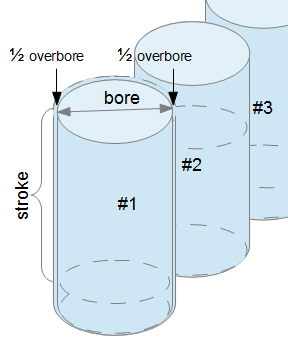The Engine Cylinder Overbore (volume) calculator computes the total engine displacement of a combustion engine with cylinder overbores.
the total engine displacement of a combustion engine with cylinder overbores.
INSTRUCTIONS: Choose units (e.g. inches, mils, millimeters) and enter the following parameters:
- (b) Bore or Diameter of Cylinders.
- (s) Stroke Length of Piston Movement in Cylinder.
- (oB) Overbore of Cylinders
- (n) Number of Cylinders
Engine Overbore Volume (V): The Total Displacement with Overbore volume is returned in cubic inches. The volume can be automatically converted to other volume units (e.g. cubic centimeters) via the pull-down menu.
The Math / Science
Overbore is the additional diameter added to a cylinder and is common in piston replacement. Note: overbore is often in the units of mils. 1 mil = 1/1000th of an inch. Engine displacement is the volume swept by all the pistons inside the cylinders of a reciprocating engine in a single movement from top dead center (TDC) to bottom dead center (BDC). Engine displacement is determined from the bore and stroke of an engine's cylinders. The bore is the diameter of the circular chambers cut into the cylinder block. When calculating engine displacement for engine with an overbore, the overbore is added to the bore in the calculation.
The total displacement with overbore of an engine formula is as follows:
`v = π⋅((b+oB)/2)^2⋅s⋅n`
where:
- v = Engine Volume
- b = bore diameter
- oB = overbore
- s = stroke length
- n = number of cylinders
Combustion Engine Calculators
Ratios and Lengths
- Cylinder Bore Diameter: Computes the diameter (bore) based on the engine displacement, number of cylinders and the stroke length.
- Bore Stroke Ratio
: Computes ratio based on the diameter of the bore and the length of the stroke.
- Combustion Ratio: Computes ratio base on the minimum and maximum displacements of the cylinder at the beginning (1-Induction) and compressed (3-Power) portions of the combustion cycle
- Displacement Ratio: Computes ratio based on the volumes at the beginning and end of the stroke.
- Rod and Stroke Length Ratio: Computes ratio base on the rod and stroke lengths.
- Stroke Length: Computes the required stroke length based on the total engine displacement, number of cylinders and the bore.
- Piston Position: Computes the piston position based on the crank angle, crank radius, and rod length.
- Piston Deck Height: Computes deck height based on Block Height, Rod Length, Stroke Length, and Pin Height.
Volumes and Displacements
- Total Volume (displacement) of a Combustion Engine: Computes volume based on the bore, stroke and number of cylinders.
- Volume (displacement) of a Engine Cylinder: Computes volume based on the bore and stroke.
- Volume (displacement) of an Engine with an Overbore: Computes volume based on the stroke, bore, overbore and number of cylinders.
- Equivalent Volume of a Rotary Engine: Estimates rotary engine volume based on the swept volume and number of pistons.
- Carburetor Air Flow: Estimates the volumetric flow of air through a carburetor based on a four-stroke engine's displacement, RPMs, and volumetric efficiency.
- Compressed Volume of a Cylinder:
Compute volume when the piston is at the end of the stroke and the chamber is at its smallest (and most compressed) volume, based on the chamber, deck, crevice, chamfer, gasket, valve relief and dome/dish volumes. This is the second volume (V2) in the Compression Ratio calculation.
- Volume of a Gasket: Computes gasket volume (displacement) based on the inner and outer diameters and the gasket's thickness.
- Volume of a Cylinder Deck: Computes the deck volume based on the deck height and the bore.
- Volume of a Cylinder Crevice: Computes crevice volume based on the piston diameter, cylinder bore and the crevice height.
- Volume of a Cylinder Chamfer: Computes chamfer volume based on the cylinder diameter and the chamfer height and width.
- Clearance Volume of a Piston: Computes the volume remaining in the combustion chamber when the piston is at its top dead center (TDC) which is the space above the piston crown when it's at its highest point in the cylinder.
- Engine Compression Ratio: Computes the ratio of the volume of the combustion chamber with the piston at its bottom dead center (BDC) to the volume with the piston at its top dead center (TDC).
Speeds and RPMs
- Piston Speed (mean): Computes the mean (average) piston speed based on stroke length and RPMs.
- Max Piston Speed: Computes max speed based on stroke length and RPMs
- RPMs: Computes revolutions per minute based on piston speed and stroke length.
Automotive Calculators
- Combustion Engine Calculator: Functions and data related to engine mechanics.
- Camber Angle: Camber angle of a tire based on size and offset.
- Camber Offset: Camber offset of a tire based on size and angle.
- Breakover angle: Ground clearance between axles
- Approach angle: Ground clearance in front of or behind vehicle.
- Belt Length: Length of a belt between and around two pulleys.
- Belt Speed: Speed of belt based on pulley RPMs and diameter.
- Pulley RPMs: Pulley RPM based on belt speed and pulley diameter.
- 2nd Pulley RPMs: RPMs of second pulley connected to a pulley, based on RPM and diameter of primary pulley and diameter of 2nd pulley.
- 2nd Pulley Diameter: Diameter needed of a second pulley connected to a primary pulley based on primary pulley diameter and RPMs, and desired RPMs of second pulley.
- RPM of 4th pulley on three shafts : RPM of a 4th pulley in a series based on diameters and initial RPM.
- 2nd Gear RPM : RPM of a second gear based on teeth in the primary and secondary gears and the RPMs of the primary gear.
